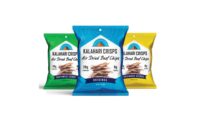
Meat Snacks
|
Estimated U.S. Retail Market Size
$3.2 billion Source: Mintel, a market research firm in Chicago |
Category Climate
The bad news for meat snacks is that the category hit
its peak during the height of the low-carb diet trend in 2003-2004. The
good news is that it brought more distribution and awareness to a category
that still remains very viable, especially the sub-segment of dried meat
snacks.
According to research from Mintel, the $3.2 billion
meat snack market increased 12 percent from 2001-2006. Growth peaked during
2004 and began to level off in 2005.
The market’s two segments, dried meat snacks and
pork rinds, both declined at current prices from 2004-2006, according to
Mintel. However, dried meat snacks’ drop was modest, the study
pointed out, and the segment’s overall performance from 2001-2006 was
up 15 percent.
Although the high-protein diet trend is not fueling
category growth as it did in past years, dried meat snacks remain a strong
snack option, thank to innovations, increased distribution and consumer
acceptance.
Product Innovation
New-product innovation has proven to be the key to
sustaining sales in meat snacks post low-carb/high-protein diet years. It
is also attracting new users to the category.
Mintel’s study revealed a move away from beef
and toward more turkey, chicken and ham, primarily because those sources
can result in a softer texture and “less-tough” chew. Popular
flavor profiles currently include spicy, barbecue, teriyaki and smoke.
Health claims such as low/no/reduced fat, low/no/reduced carbs, no
additives/preservatives, low/no/reduced trans fat and all-natural are also
getting more play in new meat-snack introductions, as are premium products.
Trends in meat-snack packaging include re-sealable
bags for larger servings and portion-control, single-serve packages.
Target Audience
During the low-carb movement, the meat snack
category’s target audience has moved beyond young males. It now
targets females, Baby Boomers and even children. The health claims and
softer textures/non-beef sources are part of the new-user attraction.
Retailing/Merchandising
In order to keep the momentum going now that sales
have slowed, retailers need to get more creative with merchandising. Mintel
believes sampling could be an effective tool to attract new users.
Promotions geared toward Hispanics (heavy users of pork rinds) should also
result in favorable sales. Asians are another up-and-coming group,
particularly with Teriyaki profiles.
Outlook
The changing U.S. demographic of younger generations
is expected to partly fuel the growth of meat snacks. However, industry
experts say that manufacturers must broaden their advertising initiatives
to appeal to women if they want to grow. Overall, Mintel expects total U.S.
sales of meat snacks to increase at an inflation-adjusted annual rate of
0.4 percent through 2011; it expects total U.S. sales of meat snacks to
increase 21 percent at current prices and 2 percent at constant prices
through 2011.
Quick Bites
Meat snacks got a
big boost from the low-carb movement.
Growth has slowed,
but increased distribution and new users are sustained.
Softer, more
flavorful options are a big hit.
Stronger
advertising and promotions are the keys to future growth.



